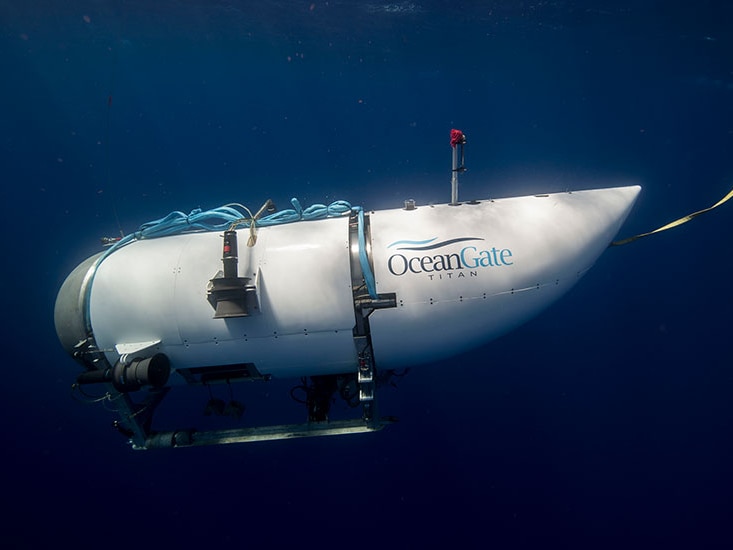A submersible has gone missing while on a dive to the wreck of the Titanic in the Atlantic Ocean.
An extensive search and rescue mission is now unfolding.
Here’s what we know so far.
What was the submersible doing?
It was carrying people down to the wreck of the Titanic.
OceanGate, a private company operating out of Washington, provides crewed submersibles for industry, research and exploration.
Each dive is meant to include a scientific objective, including studying the wreck’s decay.
The inaugural dive took place in 2021, according to the company’s website.
Following the success of its 2021 and 2022 expeditions to the Titanic wreck, OceanGate announced it would continue to return annually to monitor the decay of the iconic vessel.
OceanGate hired the Canadian vessel Polar Prince to ferry dozens of people and its Titan to the North Atlantic wreck site.
What happened to the sub?
The US Coast Guard said on Twitter that the Polar Prince lost contact with the submersible about 1 hour and 45 minutes after it began diving toward the site.
David Concannon, an adviser to the company, also confirmed this.
It had a 96-hour oxygen supply, he said in an email to The Associated Press (AP) on Monday afternoon — this was 32 hours after the sub left the surface.
Mr Concannon told the AP he was supposed to be on the dive but could not go due to a matter with another client.
Who is on board?
Among the five on board the Titan, only one name has been confirmed.
Hamish Harding, a 59-year-old British billionaire businessman and explorer, was confirmed to be on the craft by his family.
His stepson wrote on Facebook that Harding had “gone missing on [a] submarine” and he asked for “thoughts and prayers”.
The stepson subsequently removed the post, citing respect for the family’s privacy.
A day earlier, the billionaire posted on his social media that he would be aboard the submarine.
There have been no posts from him since.
Where is the Titanic wreck located?
The wreck of the Titanic lies at a depth of almost 4,000 metres at the bottom of the Atlantic Ocean, about 600 kilometres off the coast of Newfoundland in Canada.
In April 1912, the iconic ocean liner sank after hitting an iceberg.
About 1,500 people died in the sinking, with the exact figure unknown.
And some 700 people survived.
What are they doing to locate the sub?
“We are exploring and mobilising all options to bring the crew back safely,” OceanGate said in a statement.
The US Coast Guard’s Rear Admiral John Mauger said both the US and Canada were searching for the vessel in a remote area about 1,448 kilometres east of Cape Cod.
He called the search a “challenge”, but said teams were using visual and radar searches “to improve our search capability”.
“It is a remote area and it is a challenge to conduct a search in that remote area,” Rear Admiral Mauger told reporters.
“Our aerial assets that are being deployed have the capability to do both visual and radar searches, and the Canadian asset has the ability to drop sonar buoys and listen.”
What kind of conditions are rescuers facing?
In many ways, the ocean is a lot like outer space, according to Professor Arthur Trembanis from the University of Delaware.
Most of Earth’s waters remain unexplored, uncharted and unseen by our eyes.
And in the deepest marine trenches, the water pressure is more than 1,000 times greater than at sea level.
Sunlight has never penetrated these depths, making this the most unwelcoming environment on Earth.
“It’s easier to get to space than it is to get to the deep ocean,” Professor Trembanis told ABC NewsRadio this morning.
“It’s like Apollo 13 but underwater.”
“We’re talking intense pressure and currents and limited communication, all in a hostile environment.”
What does the submersible look like?
The five-person Titan is capable of diving to 4,000 metres.
It weighs 9,072 kilograms in the air, but is ballasted to be neutrally buoyant once it reaches the sea floor, according to OceanGate.
Unlike submarines that leave and return to port under their own power, submersibles require a ship to launch and recover them.
The Titan is made of “titanium and filament wound carbon fibre,” OceanGate says on its website.
It has proven to “withstand the enormous pressures of the deep ocean”.
According to the company, the sub has sensors to analyse the effects of changing pressure on the sub as it dives, in order to assess the integrity of the structure.
“This onboard health analysis monitoring system provides early warning detection for the pilot with enough time to arrest the descent and safely return to surface,” the company says.
How much does it cost to go on the sub?
OceanGate charges $US250,000 ($364,612) for a spot on its eight-day expedition to see the famous wreck in its Titan submersible.
A full dive to the wreck, including the descent and ascent, reportedly takes 8 hours.
How deep has a human gone in the ocean?
Between 35,768 and 35,856 feet (10,902–10,929 metres) — this is the depth of the planet’s deepest point: the Challenger Deep.
It’s located in the Mariana Trench in the Pacific Ocean — the deepest part of the world’s oceans.
Very few have descended to this point in the ocean — even fewer than have been to space.
But in June 2020, astronaut Kathryn Sullivan became the first person to conquer both.
Sullivan achieved a dive of 35,810 feet to the Challenger Deep.
In March 2012, filmmaker and Titanic director James Cameron made a record-breaking solo dive 35,787 feet below the surface of the Pacific Ocean.
Cameron completed the dive in the Deepsea Challenger, a deep-diving submersible built in Sydney.
Prior to Cameron’s dive, the first-ever expedition to Challenger Deep was made by the US Navy in 1960, reaching a depth of 35,800 ft.
ABC/AP
